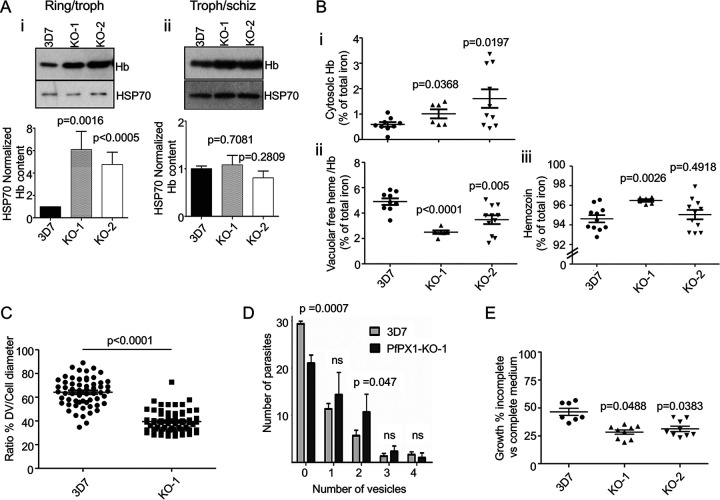FIG 6.
PfPX1 knockout lines accumulate more Hb and have a pronounced growth defect in amino acid-restricted medium. (A) Western blot analysis of Hb from saponin-freed parasites harvested at the trophozoite (3D7) and ring/trophozoite (PfPX1-KOs) stages (i) and schizont (3D7) and trophozoites/schizont (PfPX1-KOs) stages (ii). HSP70 was used as a loading control for normalization. Bar graphs represent the levels of Hb normalized to the HSP70 levels as determined by densitometry analysis. One-way ANOVA was performed for statistical evaluation. Results are expressed as mean ± SEM from 3 independent biological replicates. Troph: trophozoites. Schiz: schizonts. (B) Heme fractionation assay comparing the 3D7 WT to two PfPX1 KO lines. (B, i) Proportion of total cellular iron made up of cytosolic hemoglobin (3D7, n = 9; PfPX1-KO-1, n = 6; PfPX1-KO-2, n = 9). (B, ii) Proportion of total cellular iron made up of digestive vacuole-associated hemoglobin and free heme (3D7, n = 9; PfPX1-KO-1, n = 6; PfPX1-KO-2, n = 9). (B, iii) Proportion of total cellular iron made up of hemozoin (3D7, n = 9; PfPX1-KO-1, n = 6; PfPX1-KO-2, n = 9). Statistics were done using two-tailed unpaired t tests. (C) Digestive vacuole bloating assay. Ratio of the digestive vacuole diameter versus parasite diameter after an 8-h incubation with E64 for 3D7 and PfPX1-KO-1 lines. Each data point represents one cell. Values from three independent biological replicates are pooled together. A minimum of 20 cells per replicates were measured. A two-tailed unpaired t test was performed for statistical analysis. (D) Quantification of the number of Hb-containing vesicles as determined by IFA using an anti-Hb antibody on trophozoite (3D7) and ring/trophozoite (PfPX1-KO-1) stages. Results are expressed as mean ± SEM from a total of 50 parasites each from three independent biological replicates. Two-tailed unpaired t tests were performed for statistical evaluation. ns: not significant. (E) Evaluation of parasite growth in an amino-acid deficient medium. Tightly synchronous ring stage parasites were grown for two cycles in either complete or amino-acid deficient (containing only cysteine, glutamate, glutamine, methionine and isoleucine) medium. Data show the % of growth in amino acid-deficient medium compared to complete medium. Mean ± SEM from a minimum of seven independent experiments is shown. Unpaired t tests were performed for statistical evaluations.

